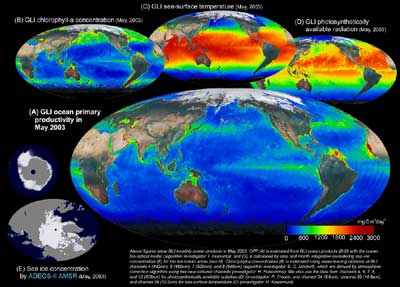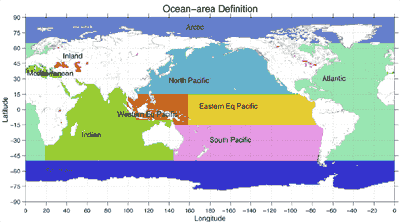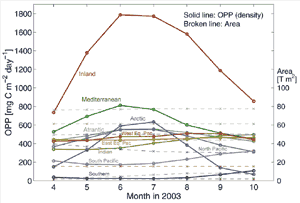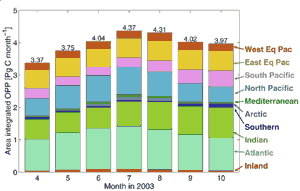Seen from Space 2004
Ocean Primary Productivity of Each Ocean Area
As countermeasures against global warming, each country is trying to curb the greenhouse effect caused by gas emissions, carbon dioxide, etc. At the present time, we do not know exactly how much carbon dioxide is absorbed by the forest and ocean. Using the following satellite data is one way of determining how much carbon dioxide is absorbed by the ocean. It can also expand our understanding of the global carbon cycle, and emission and absorption of carbon dioxide. Ocean primary productivity (OPP) is defined as the carbon per unit time and unit area set by the ocean phytoplankton's photosynthesis, taking in carbon dioxide in the oceans and making carbon, with nutrient salt like nitrogen and phosphorus, and sunlight ( http://www.eorc.jaxa.jp/en/earthview/2003/tp030627.html). As seen in image 1, distribution of OPP (A) tends to be higher around coastal areas of middle to high latitudes and on the equator, where phytoplankton's photosynthesis is active ( http://www.eorc.jaxa.jp/en/earthview/2003/tp030724.html) . OPP is estimated from chlorophyll-a concentration of phytoplankton (B) (*1), sea-surface temperature (C), photosynthetically available radiation (D) (*2), and ocean bio-optical models (*3). We introduced OPP's seasonal changes in each ocean area observed during the GLI operation period from April to October 2003. In image 2, the ocean area is classified into ten areas: Arctic, Inland, Mediterranean, Indian, North Pacific, Western Eq Pacific, Eastern Eq Pacific, South Pacific, Atlantic, and Southern.
Image 3. Represents seasonal changes of monthly mean OPP in solid-line areas and in broken-line areas in each ocean. Area varies especially in the cryosphere due to sea-ice distribution (*4). Inland OPP is high because nutrient salt is provided by land. It rises higher during June to July because many inland ocean areas are located in the northern hemisphere. The same trend can be seen in the Mediterranean, Arctic, North Pacific, and Atlantic. Meanwhile, in the South Pacific and Indian Oceans, OPP rises in early summer and towards October. In the equatorial zone, it rises a little in September. Image 4 represents each area-integrated OPP calculated by multiplying OPP by each ocean area from image 3. In the northern hemisphere, it becomes highest, and in the southern hemisphere it becomes lowest around July. In total, it becomes highest, about 4.4PgC/month, around July, which reflects more the seasonal change of the northern hemisphere. (*1) Chlorophyll-a exists in plants and plays an important role in photosynthesis. Chlorophyll-a can be a good indicator of the amount of ocean phytoplankton because it exists in all phytoplankton in common, as well as in all algae and land plants. (*2) Photosynthetically available radiation indicates the amount of sunlight available for photosynthesis. It is highest around the equator where the sunlight penetrates more easily. (*3) To estimate OPP with satellite data, several methods of ocean bio-optical model are being suggested. Each method is still being researched, assessed, and improved. This example's image is processed using an algorithm developed by Mr. Asanuma of JAMSTEC. We expect the estimated OPP and the models will enable us to learn more about the ocean ecosystem and global mechanism of environmental changes like global warming. (*4) Estimated from sea-ice concentration derived by AMSR (Image 1-(E)). |







